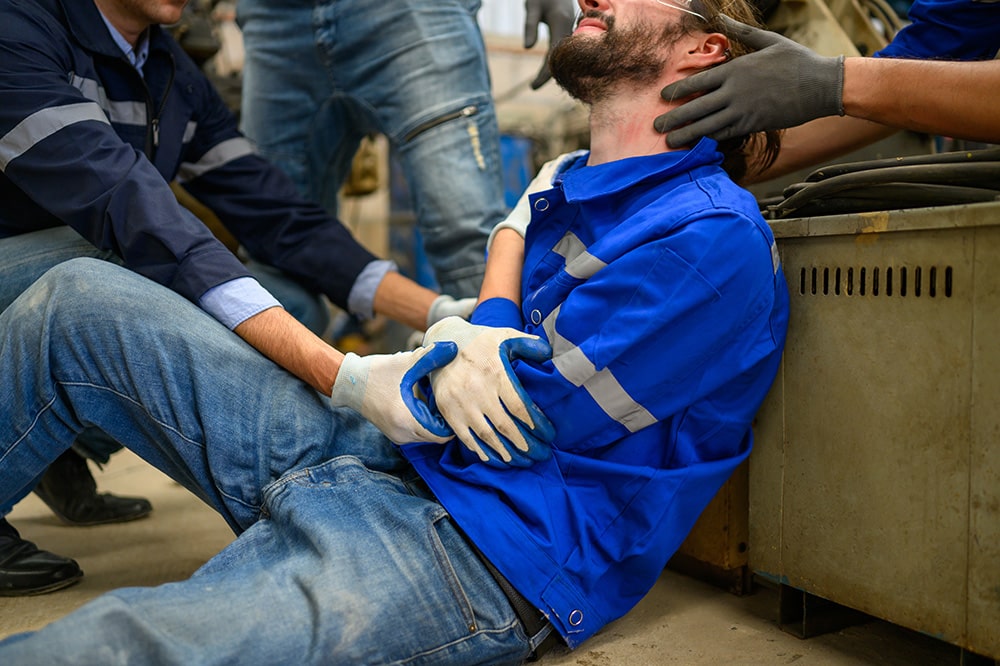Our arms help us perform daily activities, aiding in everything from performing necessary job duties to completing basic tasks. Yet, when trauma strikes and an individual sustains an injury to the arm, it can profoundly impact not only their physical abilities but also their financial stability.
If you find yourself dealing with an arm injury sustained on the job, you are not alone. Our team of dedicated healthcare providers is here to help you heal. Through a comprehensive evaluation process, we develop a thorough understanding of your specific injury and build a personalized treatment plan tailored to your unique needs and circumstances.
In addition, we understand the importance of proper documentation in supporting your workers' compensation claim. By diligently recording your progress and communicating with relevant parties, we help ensure you receive the workers’ compensation benefits and support you deserve during this challenging time.
If you're ready to take the first step toward healing, contact our team at Spine and Joint Institute of Milwaukee to schedule an appointment today.

Common types of arm injuries that may be suffered at work include:
Arm Fractures. Fractures or broken bones in the arm can occur due to falls, being struck by objects, or accidents involving heavy machinery or equipment.
Sprains and Strains. Sprains involve stretching or tearing ligaments, while strains involve stretching or tearing muscles or tendons. These injuries can result from overexertion, lifting heavy objects, or repetitive movements.
Dislocations. Dislocations occur when the bones in the arm are forced out of their normal positions at the joints. This can happen due to falls, sudden impacts, or awkward movements.
Tendonitis. Tendonitis is inflammation or irritation of the tendons, which can cause pain, swelling, and restricted movement. It often occurs due to repetitive motions, such as typing, lifting, or assembly line work.
Carpal Tunnel Syndrome. While primarily affecting the wrist and hand, carpal tunnel syndrome can also cause symptoms in the arm. It occurs due to compression of the median nerve in the wrist, often due to repetitive hand and wrist movements.
Bruising and Contusions. Bruises and contusions can occur on the arms due to impacts with objects or surfaces in the workplace.
Lacerations and Abrasions. Cuts, lacerations, and abrasions can result from contact with sharp objects or machinery in the workplace.
Burns. Burns to the arms can occur from exposure to hot surfaces, chemicals, or flames in the workplace.
Repetitive Strain Injuries (RSIs). RSIs can affect various parts of the arm, including the wrist, forearm, and elbow. They develop gradually over time due to repetitive movements, poor ergonomics, or prolonged periods of activity.
Crush Injuries. Crush injuries occur when the arm is caught or compressed between heavy objects or machinery. These injuries can result in fractures, soft tissue damage, and nerve damage.

If you've sustained an arm injury at work, taking appropriate steps to ensure your health and well-being is crucial. Remember that every injury and workplace situation is unique, so adapting these steps to your specific circumstances is critical. If you have any concerns or questions, don't hesitate to consult with healthcare professionals, legal advisors, or your employer's human resources department for guidance. Here's a general guide on what you should do:

If the injury is severe or you're in pain, seek medical attention immediately. This may involve calling emergency services or visiting the nearest emergency room.
Notify your supervisor or manager about the injury immediately. Most workplaces have protocols for reporting injuries; following these procedures is essential.
Keep detailed records of the injury, including the time, date, location, and circumstances surrounding the incident. Take photographs if possible. Documentation may be necessary for filing a workers' compensation claim or for legal purposes.
Adhere to any treatment recommendations provided by healthcare professionals. This may include medication, rest, physical therapy, or wearing a brace or sling.
You may be entitled to workers' compensation benefits if the injury occurred at work. Follow your employer's procedures for filing a claim and consider seeking assistance from a workers' compensation attorney if needed.
Keep your employer informed about your medical condition and any limitations or restrictions you may have due to the injury. This will help facilitate your return to work once you're medically cleared.
Attend all scheduled follow-up appointments with healthcare providers and comply with their recommendations for recovery and rehabilitation.
If your injury affects your ability to perform specific job duties, discuss possible accommodations or modifications with your employer. This could include temporary light-duty assignments or adjustments to your workstation.
Allow yourself adequate time to heal and recover from the injury. Avoid rushing back to work before you're medically cleared, as this could exacerbate the injury or lead to further complications.
If you're experiencing physical or emotional challenges due to the injury, don't hesitate to seek support from friends, family, or mental health professionals. Dealing with a workplace injury can be stressful, and it's important to prioritize self-care.
Managing pain after trauma to the arm at work is important for promoting healing and improving comfort. It's imperative to consult with a healthcare provider specializing in arm injuries for an accurate diagnosis and personalized treatment plan for managing arm pain after trauma. They will help determine the most appropriate interventions based on the nature and severity of the injury. Additionally, practicing good ergonomic habits and avoiding activities that could exacerbate pain can help prevent further injury and promote recovery. Here are some ways to effectively manage arm pain with the guidance of a work injury doctor:
Resting the injured arm is crucial to healing the tissues. Avoid activities that exacerbate pain or strain the injured area.
Applying ice packs or cold compresses to the injured area can help reduce pain, inflammation, and swelling. Apply ice for 15-20 minutes every few hours, especially during the first 48 hours after the injury.
Elevating the injured arm above the level of the heart can help reduce swelling and promote fluid drainage from the injured area. Use pillows or cushions to support the arm while lying down or sitting.
Over-the-counter pain relievers such as acetaminophen (Tylenol) or nonsteroidal anti-inflammatory drugs (NSAIDs) like ibuprofen (Advil, Motrin) can help alleviate pain and reduce inflammation. Follow the recommended dosage instructions and consult a healthcare professional if needed.
Applying compression to the injured arm with an elastic bandage or wrap can help reduce swelling and provide support. Ensure the compression is not too tight, as it may impede circulation.
After the initial acute phase of injury, applying heat to the affected area with warm compresses or heating pads can help relax muscles, improve blood flow, and alleviate pain. Heat therapy is generally more beneficial for chronic pain or stiffness.
Participating in a structured physical therapy program can help improve the injured arm's range of motion, strength, and flexibility. A physical therapist can provide exercises, stretches, and manual techniques tailored to your injury and needs.
Massage therapy can help relieve muscle tension, reduce pain, and promote relaxation in the injured arm. It can be particularly beneficial for soft tissue injuries and chronic pain.
Transcutaneous Electrical Nerve Stimulation therapy involves using a small, battery-operated device that delivers low-voltage electrical impulses to the skin to block pain signals. TENS units can be utilized at home under the guidance of a healthcare professional.
Compared to other work-related injuries, arm injuries are especially complex and can result in permanent disability. That’s why it’s critical for injured workers to get immediate care from healthcare providers who are specially trained in diagnosing and treating arm pain from workplace injuries.
At Spine and Joint Institute of Milwaukee, your recovery is our top priority. That’s why, in addition to our comprehensive work injury care, we know exactly how to document your injuries and organize your medical records for your workers’ compensation case, allowing your attorney to ensure you receive the maximum compensation you need and deserve.
Have you suffered an arm injury and need workers’ compensation benefits? Our trusted medical professionals are here to help you heal while building the necessary documentation to pursue your claim. Together, we will get you on the road to recovery.

If you are not receiving proper care for your injury, you have the right under Wisconsin Workers' Compensation Law to choose your own doctor and to get a second opinion.